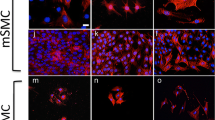Summary
Recent studies indicate that the neointima of injured rat arteries is composed of a subpopulation of smooth muscle cells (SMCs) distinct from medial smooth muscle cells. However, SMC diversity in normal adult aorta has remained elusive. This study characterizes two morphologically and functionally distinct SMC types isolated from different anatomic regions of the normal rat aorta. Rat aortic medial smooth muscle cells (MSMCs) were isolated from the media after removal of the intimal and adventitial cells. Rat aortic intimal smooth muscle cells (ISMCs) were isolated from the intimal aspect of everted rat aortas. The two cell types were characterized morphologically and immunohistochemically and were compared for their capacity to contract collagen gels in response to endothelin-1. MSMCs were spindle-shaped and grew in hills and valleys showing features previously described for vascular SMCs. Conversely, ISMCs displayed a polygonal and epithelioid shape, grew mainly as a monolayer, and had a higher proliferative rate. Both cell types expressed alpha-smooth muscle actin and were negative for Factor VIII-RAg. ISMCs produced large amounts of a laminin and type IV collagen-rich extracellular matrix which had a characteristic pericellular distribution. ISMCs, but not MSMCs, rapidly contracted collagen gels in response to endothelin-1. This study indicates that the normal rat aorta contains two types of SMCs located in anatomically distinct regions of the vessel wall. Because of their functional characteristics, the SMCs isolated from the intimal aspect of the aorta may play an important role in physiologic as well as pathologic conditions.
Similar content being viewed by others
References
Battistini, B.; D’Orlèans-Juste, P.; Sirois, P. Biology of disease. Endothelins: circulating plasma levels and presence in other biologic fluids. Lab. Invest. 68:600–628; 1993.
Cavallero, C.; Turolla, E.; Ricevuti, G. Cell proliferation in the atherosclerotic plaques of cholesterol fed rabbits. Atherosclerosis 13:9–20; 1971.
Chamley-Campbell, J.; Campbell, G. R.; Ross, R. The smooth muscle cells in culture. Physiol. Rev. 59:1–61; 1979.
Chamley-Campbell, J. H.; Campbell, G. R. What controls smooth muscle phenotype? Atherosclerosis 40:347–357; 1981.
Clowes, A. W.; Clowes, M. M.; Reidy, M. A. Kinetics of cellular proliferation after arterial injury. III. Endothelial and smooth muscle growth in chronically denuded vessels. Lab. Invest. 54:295–303; 1986.
Elsdale, T.; Bard, J. Collagen substrata for studies on cell behaviour. J. Cell. Biol. 54:626–637; 1972.
Fishman, J. A.; Ryan, G. B.; Karnovsky, M. J. Endothelial regeneration in the rat carotid artery and the significance of endothelial denudation in the pathogenesis of myointimal thickening. Lab. Invest. 32:339–351; 1975.
Gerrity, R. G.; Cliff, W. J. The aortic tunica intima in young and aging rats. Exp. Mol. Pathol. 16:382–402; 1972.
Giachelli, C. M.; Majesky, M. W.; Schwartz, S. M. Developmentally regulated cytochrome P-450IA1 expression in cultured rat vascular smooth muscle cells. J. Biol. Chem. 266:3981–3986; 1991.
Majesky, M. W.; Giachelli, C. M.; Reidy, M. A., et al. Rat carotid neointimal smooth muscle cells reexpress a developmentally regulated mRNA phenotype during repair of arterial injury. Cir. Res. 71:759–768; 1992.
Nicosia, R. F.; Bonanno, E.; Villaschi, S. Large vessel endothelium switches to a microvascular phenotype during angiogenesis in collagen gel cultures of rat aorta. Atherosclerosis 95:192–199; 1992.
Nicosia, R. F.; Villaschi, S.; Smith, M. R. Isolation and characterization of vasoformative endothelial cells from the rat aorta. In Vitro Cell. Dev. Biol. 30A:394–399; 1994.
Schwartz, M. W.; Reidy, M. A.; Clowes, A. W. Kinetics of atherosclerosis: a stem cell model. Ann. NY Acad. Sci. 454:292–304; 1985.
Stary, H. C.; McMilan, G. C. Kinetics of cellular proliferation in experimental atherosclerosis. Arch. Pathol. 89:173–183; 1970.
Vane, J. Endothelins come home to roost. Nature 348:673; 1990.
Villaschi, S.; Nicosia, R. F. Angiogenic role of endogenous basic fibroblast growth factor released by rat aorta after injury. Am. J. Pathol. 143:181–190; 1993.
Walker, L. N.; Bowen-Pope, D. F.; Ross, R., et al. Production of platelet-derived growth factor-like molecules by cultured arterial smooth muscle cells accompanies proliferation after arterial injury. Proc. Natl. Acad. Sci. USA 83:7311–7315; 1986.
Yanagisawa, M.; Kurihara, H.; Kimura, S., et al. A novel potent constrictor peptide produced by vascular endothelial cells. Nature 332:411–415; 1988.
Author information
Authors and Affiliations
Rights and permissions
About this article
Cite this article
Villaschi, S., Nicosia, R.F. & Smith, M.R. Isolation of a morphologically and functionally distinct smooth muscle cell type from the intimal aspect of the normal rat aorta. Evidence for smooth muscle cell heterogeneity. In Vitro Cell Dev Biol - Animal 30, 589–595 (1994). https://doi.org/10.1007/BF02631257
Received:
Accepted:
Issue Date:
DOI: https://doi.org/10.1007/BF02631257




